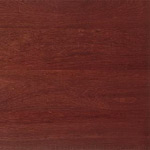For a quicker response, please send all inquiries
via info@canfloor.com or
text to
416-735-0075.
| Monday - Friday | 10:00 am - 7:00 pm |
| Saturday & Sunday | 10:30 am - 4:00 pm |

Scientific Name: Peltogyne spp.
Other Names and Species: Amaranth, Amarante, Guarabu, Koroboreli, Morado, Palo Morado, Pau Roxo, Purperhart, Tananeo, Violetwood
Origin: North-middle part of the Brazilian Amazon region of South America, as well as in tropical regions of Central America.
Appearance: The off-white or lighter cream color of the sapwood of purpleheart contrasts sharply with the heartwood, which is brown when freshly cut, changing to a deep, vibrant purple or purplish brown over time. The texture of this wood is medium to fine, with a medium-to-high luster and a grain that is usually straight, or sometimes wavy, roey, or irregular.
Properties: Purpleheart is a very hard, dense, strong wood, with excellent dimensional stability. It is very resistant to dry-wood termites.
Workability: Frequent sharpening of tools may be required when working this wood, due to its hardness. The wood may exude a gummy resin when heated by friction with dull tools. Carbide tooling and a slow feed rate are recommended. It sands satisfactorily and takes finishes well. Water-based finishes tend to hold color better.
Principal Uses: Purpleheart is prized for its uniquely vivid purple color, and so it is used in many speciality items, such as billiard cue butts and decorative carving. As a flooring material, the wood makes for very dramatic edgings, inlays, and accents. It is also used widely in parquet, fine furniture and cabinet work, marquetry, tool handles, diving boards, and shipbuilding. Because of its acid-resistance, it is also used in making chemical vats.
